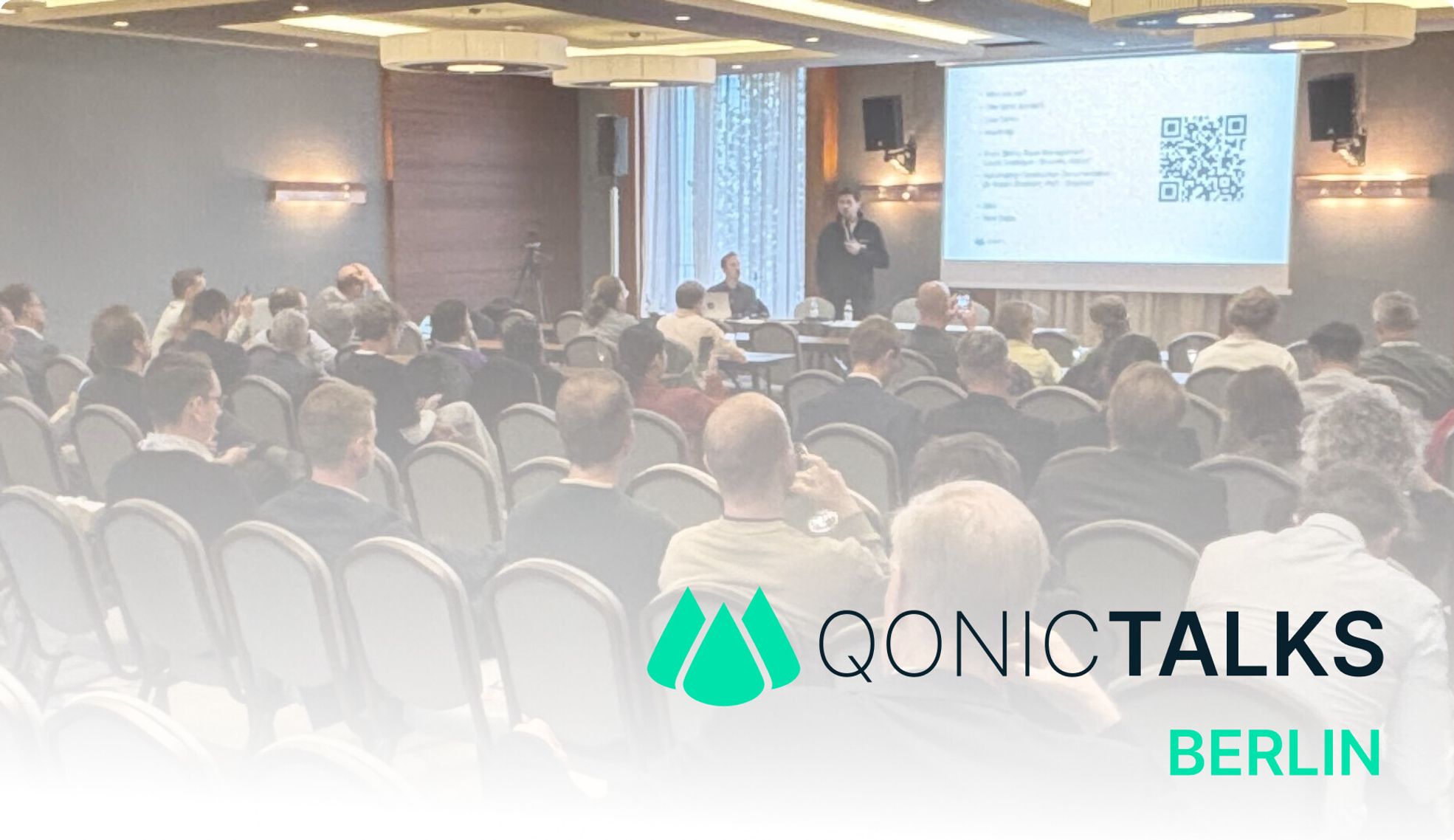More than sixty people packed the room at the Titanic Hotel during the buildingSMART International Summit. The energy in the room was clear: new visitors were blown away by what they saw, while the “usual suspects” couldn’t believe how fast things are moving.

What Qonic is
Qonic is a fast, browser-first BIM environment that treats IFC as the native data model. You open large models instantly, collaborate without hardware headaches, and keep data intact across design, coordination and delivery.
In short: one place to work together, without the file and format grind.
And because standards only succeed when they’re accessible, Qonic runs on modest devices and keeps workflows simple, so more people can confidently participate in openBIM.
Watch the aftermovie here:
What we showed
The live demo proved that Qonic isn’t just a viewer. It’s an environment where data is enhanced and remains usable throughout the project.
We walked through a full loop:
evaluate → enrich → collaborate → deliver
with clean IFC as the baseline, not the afterthought.
What this means in practice:
- Data enhancement to clean and enrich IFC
- Clash detection to coordinate disciplines with confidence
- Git-like versioning to manage changes transparently
- Quantity reports generated directly from the model
Qonic supports the entire value chain: designers refining ideas, contractors managing quantities and clashes, facility managers following up assets and anyone who wants to collaborate without technical barriers.
These choices — our focus on openBIM, and a sustainable, efficient approach — are also why Qonic Intelligence (QI) won the buildingSMART openBIM Award 2025.🏆
It’s a milestone we’re proud of, and one that shows how central clean IFC data is to everything we do.
👉You can read the full story of QI and why it matters here.

Roadmap highlights
What’s coming next builds on the same promise: faster, smarter, boundaryless BIM.
- Component Libraries to place and reuse elements efficiently
- Procedures to automate repetitive modelling tasks
- Natural Language Engagement to query models in plain words
- Spaces for clearer spatial understanding
- 4D Planning linked directly to model geometry
- Open interoperability with Rhino, SketchUp, Revit, and IFC
- Qonic API so teams can extend workflows on their own terms
Stories from practice
Brussels Airport — BIM × Asset Management
Louis Casteleyn presented a proof of concept connecting IFC in Qonic with Maximo. The key takeaway: when classification is reliable and data stays true to the model, asset handover stops depending on brittle exports and manual mapping. What used to be “data wrangling” becomes a direct link between design intent and asset records.
Graebert — Automating construction documentation
Dr. Robert Graebert demonstrated how Qonic leverages Graebert technology to generate construction documents that actually reflect the model without redrawing. The value is twofold: drawings follow office standards, and they stay aligned as the model evolves.
Looking back and ahead
Berlin showed it clearly: the future is about solving project problems. Clean IFC by default, faster decision-making and inclusive workflows: that’s the path we’re on.
👉Want to see it yourself? Upload a model and get started at qonic.com/get-started.
We closed with a Q&A session of 25 questions. From modelling logic and IFC management to collaboration and future roadmap, the discussion showed exactly where the industry’s needs are.
Q&A Recap
Modelling in Qonic
1. Is Qonic a modelling tool that allows starting from scratch?
Qonic already has the foundations of a full modelling environment, and we’re expanding our authoring tools every month. While it’s possible to create models from scratch today (for example starting from grids or basic geometry), most users currently find the greatest value in Qonic by editing, enriching and cleaning existing models imported from IFC, SketchUp, Revit or Rhino. Over time, we’re evolving towards a more complete modelling workflow.
2. Do you plan to introduce parametric constraints for components, like the Revit Family Editor?
Not in the same way. Qonic’s approach is to keep modelling flexible and intuitive, without locking you into rigid families. We focus on templates, reusable elements and libraries so you can stay efficient, but with fewer restrictions than in traditional parametric systems.
3. Are you planning to add a tool palette with templates, similar to Revit Families?
Yes. Libraries and templates are actively being developed, so customised elements can be saved and reused by teams.
4. If a door is moved in a structural wall, does the wall opening move with it?
Yes, if the class is set to Door. Openings move automatically with the door to maintain consistency. Structural engineers may still need to check feasibility, but the geometry and IFC logic remain correct.
5. Is it possible to place model elements automatically at grid intersections (e.g. columns)?
Yes. Grid snapping is supported, so elements like columns can be placed at intersections with precision.
6. What about 2D documentation and detailing?
Drawing generation is on the roadmap. Floor plan views and sections are under active development so Qonic can cover both 3D and 2D needs.
Data, Standards & Interoperability
7. Which IFC versions does Qonic support?
Currently IFC2x3 and IFC4. As new versions are released and adopted, we will expand support accordingly.
8. What were the main pain points in implementing IFC as a native data schema?
The biggest challenge is that IFC exports from authoring tools are often messy and inconsistent. That’s why Qonic uses IFC as its native data structure, and why we developed Qonic Intelligence (QI): to automatically classify and clean IFC so teams can rely on it.
9. Will it be possible to add properties and classes from bSDD as well?
Yes. Qonic already supports bSDD for classification, so data can be enriched and standardised consistently.
10. Does Qonic support BCF?
At this moment, Qonic does not support BCF import or export. Issue tracking and coordination are handled directly inside Qonic, with location pins and version history. BCF interoperability is on our development roadmap for the future.
11. Can I generate IfcOpeningElements for a round-trip approval process?
Yes. Qonic supports openings as proper IFC entities, which makes round-tripping possible.
Collaboration & Versioning
12. Can conflicts between two models be communicated?
When two people edit the same element in different models, Qonic shows a conflict. You can then choose which version to keep when resolving it. We’re also working on richer conflict-handling with clearer notifications and improved tracking of who changed what.
13. In the Git-like revision system, can you assign a person responsible for conflict resolution?
Yes. Assigning a “model lead” or responsible reviewer for conflicts is part of our roadmap, so it doesn’t just fall to whoever syncs last.
14. Can I restrict editing rights for specific elements or parameters?
Permissions in Qonic are set at the model level, not for individual elements or parameters. That means you can decide whether someone can edit data, adjust geometry, or only view the model but you can’t yet lock specific objects or properties inside it.
15. Is there a “follow me” function to guide someone through my model?
Not yet. Collaborative walkthroughs and guided reviews are on the roadmap, with the option to save comments as BCFs.
16. Are models stored locally and synced, or streamed from the server?
Models are stored in the cloud and streamed to users. For archiving, IFC exports ensure models can be opened even 5+ years later.
Roadmap & Integrations
17. Is it on the roadmap to visualise point clouds?
Yes. Point cloud import and visualisation (e.g. E57 format) is planned.
18. Are you planning to support importing underlay formats like PDF/DWG, including QTO?
Yes. PDF/DWG underlays and QTO functionalities are part of our roadmap. Importing underlay formats like PDF and DWG is on our roadmap, so you can use them as a reference in Qonic. However, QTO (quantity take-off) on PDF/DWG underlays is not planned.
19. Are simulations or regulatory checks on the roadmap?
Full rule-based simulation or automated compliance checking (e.g. fire safety or accessibility) is not available in Qonic today. However, we know this is highly requested in many regions, and we are exploring how to extend our checking capabilities in the future. Already now, tools like the laser measurement help with manual checks (for example evacuation corridor widths), and IDS (Information Delivery Specification) checking will soon be available to validate data requirements.
20. In your drawing automation roadmap, do you plan to add a learning function so the tool can replicate drawing standards?
Qonic’s drawing automation is focused on speed, consistency, and alignment with open standards. A self-learning function that replicates office-specific CAD standards is not on our current roadmap.
21. How can I get started with the API?
You can get started with the Qonic API by visiting our API documentation. If you need additional support or access keys, please contact our support team.
22. Which languages are supported in the LM?
Currently English, with more languages to follow.
23. Where is Qonic hosted? Is the service C5 and DSGVO certified?
Qonic runs on secure European cloud infrastructure, fully GDPR-compliant. Certifications such as C5 are provided by our hosting provider.
Position & Vision
24. What is Qonic’s position in the design process?
Qonic sits between design and delivery. It’s flexible enough for early modelling, but robust enough for coordination, classification, and validation across the full project lifecycle.
25. Jacob, would you like to join the BIMup podcast?
Ofcourse, we’d be happy to join and share more about Qonic!😀
